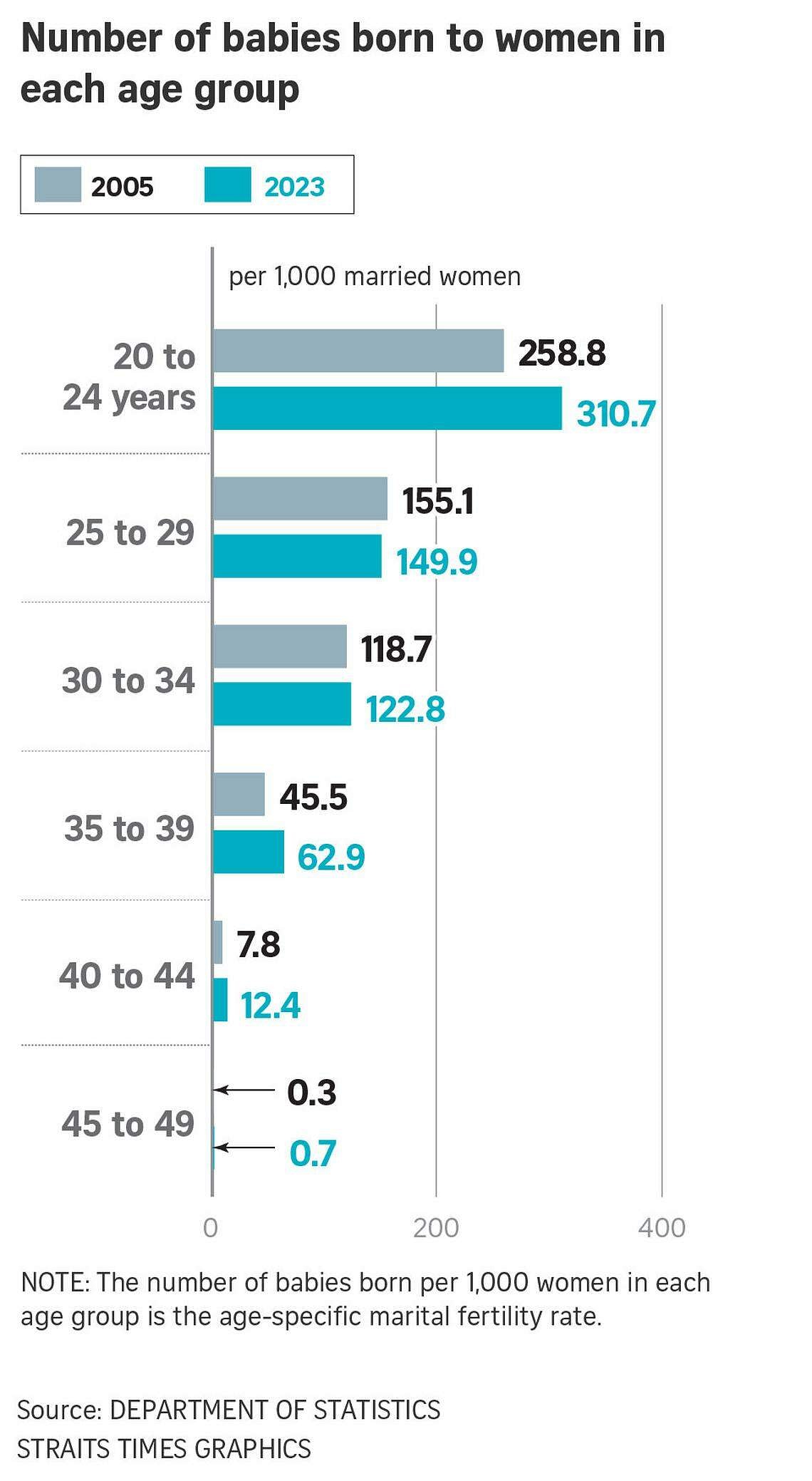Rising share of women staying single is behind S’pore’s great baby drought


SINGAPORE - The growing share of women remaining single is one major reason for Singapore’s longstanding baby drought, with the resident total fertility rate (TFR) falling to below 1 in 2023 for the first time in Singapore’s history.
A Department of Statistics (DOS) analysis of the factors behind the falling TFR found that the drop in the TFR between 2005 and 2023 was due to a decline in the proportion of married women, which offset slight increases in the fertility rate of married women.
The analysis, published in the DOS newsletter in May, comes after Singapore’s resident TFR fell to 0.97 in 2023 – which is among the lowest in the world. The TFR refers to the average number of babies each woman would have during her reproductive years.
If more Singaporeans remain unwed, what this means is that Singapore’s TFR is likely to continue to fall, said the academics who study population issues.
Professor Jean Yeung, director of social sciences at the Agency for Science, Technology and Research’s Institute for Clinical Sciences and a professor at NUS’ Yong Loo Lin School of Medicine, said: “Since we will have an increasingly small number of women at a marriageable and child-bearing age, and births outside of wedlock are illegitimate in Singapore, the number of citizen births will likely continue to decline if the marriage rates keep declining.”
This is sobering news for Singapore, which has put in place an arsenal of measures to boost the birth rate in the past 20 over years. This includes Baby Bonus cash gifts for newborns, more maternity and paternity leave, and extending Government co-funding for in-vitro fertilisation treatment for older women.
In its analysis, the DOS compared the TFR for two different periods due to the difference in the data trends observed, its spokesperson told The Sunday Times.

By signing up, I accept SPH Media's Terms & Conditions and Privacy Policy as amended from time to time.
Between 1990 and 2005, the decline in the fertility rate of married women contributed more to the drop in the TFR than the fall in the proportion of married women. The fertility rate of married women is also known as marital fertility.
But between 2005 and 2023, the drop in the TFR was due to the fall in the proportion of married women, which offset slight increases in marital fertility.
In particular, the DOS spokesperson said the fall in the TFR could be mainly attributed to the drop in the proportion of married women between the ages of 20 and 34.
For example, the proportion of married women aged 25 to 29 fell from 52.1 per cent of all women in that age group in 2005 to 29.2 per cent of all women in that age group in 2023.
Meanwhile, marital fertility was higher across most age groups in 2023, compared with 2005.
For example, the marital fertility rate for women aged between 35 and 39 rose from 45.5 per 1,000 married women in 2005 to 62.9 per 1,000 married women in 2023.
The DOS spokesperson said the rise in marital fertility rates for women in the older age groups arose from women getting married and giving birth at an older age.
Marriage no longer seen as a life goal
Population experts say that many Singaporeans feel that they do not have to marry, if they cannot find Mr or Miss Right, hence the increasing prevalence of singlehood.
Besides, marriage is no longer seen as a required life goal in Singapore, said Dr Mathew Mathews, principal research fellow at the Institute of Policy Studies (IPS).
Dr Mathews said: “The stigma towards those who are unmarried has rapidly waned, which is a really good thing.
“For quite a long time, the idea that a single person of marriageable age remaining unmarried was seen as undesirable.
“These individuals were viewed with some level of pity, with others supposing their lives would not be fulfilled, or they had some characteristic which made them less desirable as marriage partners.”
IPS senior research fellow Kalpana Vignehsa co-authored a study that found that women aged between 21 and 34 were significantly less interested in marriage and parenthood than men in their age group. The study polled about 2,400 Singapore residents in 2023.
While the study did not ask respondents for their reasons behind their answers, Dr Vignehsa said the women she spoke to in her other research told her they are worried they have to shoulder the bulk of caregiving and other domestic responsibilities.
She said: “They talk about watching their mothers burn out from being primarily responsible for the visible and invisible labour of running a family on top of full-time employment, and they aren’t convinced that their male counterparts are ready to be equal partners at home.”

Is raising the TFR a lost cause?
The DOS analysis noted that Singapore’s resident TFR has been on a “declining trend” for the past 30 years. In 1990, it was 1.83, and that fell to 1.26 in 2005.
But given the gravity of the matter, population experts say Singapore cannot afford to see the baby drought as a lost cause.
According to the experts, the good news is surveys consistently show that many young Singaporeans still want to get married and have children.
The areas where Singapore can do more to tackle the issue include reducing the work-family life conflict, getting husbands to step up on the home front and mandating the additional two weeks of paid paternity leave, said those interviewed.
Working fathers of Singaporean children born on or after Jan 1, 2024, are now entitled to four weeks of government-paid paternity leave, up from two weeks. But for now, employers have the option to voluntarily grant the additional two weeks’ leave, which will be reimbursed by the Government.
Prof Yeung said: “If the leave needs an extra layer of approval from the employers, that deters fathers from asking for them, and fewer fathers will take them.
“Research shows men will take paternity leave only when it is on a ‘take it or lose it’ basis. We need this change to have a significant impact on gender norms in Singapore.”
But beyond policies and schemes to promote marriage and parenthood, what is harder to achieve is to address the root causes of the beliefs that make having children seem so costly and daunting, the experts say.
Dr Tan Poh Lin, an IPS senior research fellow, said: “It requires directly addressing the root causes of why some parents feel so deeply stressed out, and how healthier views can replace the most unhealthy forms of parenting culture that cause parents to push themselves and their children too hard.”
Dr Vignehsa noted that many parents remain anxious about the cost of living, no matter how much Baby Bonus they have received, as it does not alleviate their financial anxiety in the long term.
Ironically, she said, financial incentives may bolster many Singaporeans’ belief that having more money makes them better off – and so these parents feel they cannot afford to stop the daily grind, or they would lose out comparatively.
She said: “I think if we want people to have more significant relationships and have more babies, we need policies that change what people feel is required of them to survive and thrive.
“And these requirements need to be compatible with modern child-rearing, which comprises more parental involvement and more equal involvement from both parents.”
Special offer: $0.25/week
Unlimited access to news, lifestyle & multimedia content!
ST One Digital - Monthly
$9.90/month $0.99/month
No contract
$0.99/month for the first 6 months, $9.90/month thereafter. T&Cs apply.
Discover exclusive benefits:
All subscriber-only content on ST app and straitstimes.com
Easy access any time via ST app on 1 mobile device
myST: Follow up to 30 authors and 30 topics
Join ST's WhatsApp Channel and get the latest news and must-reads.








No comments:
Post a Comment